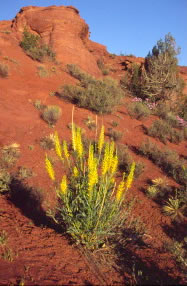 You
may have cursed last winter’s rains, as cold moisture
carried aloft by an off-balanced Jet Stream danced down across
your desert roof. You may have muttered that if you wanted
to live in the Northwest you would have stayed in soggy Seattle,
and not left those dripping conifers for the dryness of the
Southwest. Maybe you took advantage of the abundant snowfall,
swooshing and slicing your way through powder heaven here
in the Red Rocks. Maybe you stayed at home and wondered what
all this moisture would bring come spring. You
may have cursed last winter’s rains, as cold moisture
carried aloft by an off-balanced Jet Stream danced down across
your desert roof. You may have muttered that if you wanted
to live in the Northwest you would have stayed in soggy Seattle,
and not left those dripping conifers for the dryness of the
Southwest. Maybe you took advantage of the abundant snowfall,
swooshing and slicing your way through powder heaven here
in the Red Rocks. Maybe you stayed at home and wondered what
all this moisture would bring come spring.
Well, spring is now upon us like an anxious puppy. And depending upon
how you see life, you might say that the desert is either half full of
weeds or that the desert is half full of wildflowers.
April’s showers may bring May’s flowers, but here in Canyon
Country there is nothing like a good winter soaking. For the desert is
full of seeds, tiny containers of life just waiting for the right set
of environmental conditions.
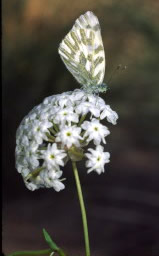 Though “waiting” might
be too anthropomorphic of a term, these seeds have been lying dormant
in the desert, some for many years. As these seeds represent future generations
and continuation of their species, they are designed or programmed with
safety measures should the seeds be “fooled” into germination.
For if there is insufficient soil moisture to sustain their germination,
the seedlings will not survive. Thus, there needs to be adequate moisture
that penetrates the soil and through the seed. Only then will the chemical
keys that inhibit the seed from germinating prematurely be turned. And
because of this winter’s rains, many of these seed bolts were thrown
back. Though “waiting” might
be too anthropomorphic of a term, these seeds have been lying dormant
in the desert, some for many years. As these seeds represent future generations
and continuation of their species, they are designed or programmed with
safety measures should the seeds be “fooled” into germination.
For if there is insufficient soil moisture to sustain their germination,
the seedlings will not survive. Thus, there needs to be adequate moisture
that penetrates the soil and through the seed. Only then will the chemical
keys that inhibit the seed from germinating prematurely be turned. And
because of this winter’s rains, many of these seed bolts were thrown
back.
You can see this difference just driving into Moab. A green fuzz has
sprouted from the barren face of the desert. Though many weedy plants
like cheatgrass, African mustard or tansy mustard have taken advantage
of this moisture, there are a vast number of native plants intermingling
with these weeds. Though the weeds have a taken a hare’s lead in
the flowering race, the natives plod along with a tortoise-like pace.
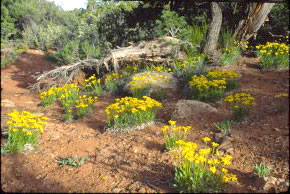 Soon
vast stretches of ground will be filled with the Kleenex® white blooms
of evening primrose, woody asters and sand verbenas. Hillsides normally
reserved for scampering lizards will soon be filled with coils of scorpionweed
or satellite dish towers of orange globemallow flowers. Soon
vast stretches of ground will be filled with the Kleenex® white blooms
of evening primrose, woody asters and sand verbenas. Hillsides normally
reserved for scampering lizards will soon be filled with coils of scorpionweed
or satellite dish towers of orange globemallow flowers.
This does not mean that the yellow beeplant or the prince’s plume,
with their bottlebrush arrangement of flowers, should be overlooked.
No, for during these years when winter’s rains have come in force,
these plants either carpet the desert in fields of golden yellow or seem
to explode forth from the rocky hillsides.
Associated
with these years of massive floral 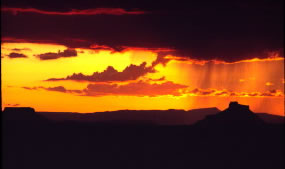 displays come waves of insect pollinators
to feast on the fruits, nectars and pollen produced by the plants. At
times it seems as if the desert takes on the low hum, as hundreds of
wingbeats carry flies, bees, wasps, beetles, hummingbirds, moths, and
butterflies to and fro in these fields of flowers. displays come waves of insect pollinators
to feast on the fruits, nectars and pollen produced by the plants. At
times it seems as if the desert takes on the low hum, as hundreds of
wingbeats carry flies, bees, wasps, beetles, hummingbirds, moths, and
butterflies to and fro in these fields of flowers.
So this spring, steal away some moments to take in this profusion of
blossoms, for blooms of this magnitude are not an annual event here in
the land of little rain. Then, the next time the winter is leaden with
gray skies, curse not the precipitation. For you’ll have seen how
these winter rains bring on a profusion of spring flowers.
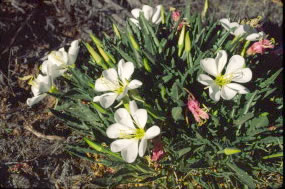
|